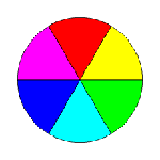The Wonderful World of
Mixing Colors
Introduction | Task | Resources | Process | Evaluation | Conclusion
Knowing how to mix colors is a skill that everyone needs to know. The color wheel can help you when it comes to mixing colors. The color wheel is a circle that has the primary and secondary colors in a specific order and by looking at a primary color's placement on the wheel, you can decide which primary colors you need to mix in order to get the proper secondary color that you want to create. Mixing colors is a very essential skill to have and is very useful when it comes to art projects, mixing light, and various other life circumstances.
To learn how to use the color wheel to mix and create colors using just the primary colors. Once this has been done, these concepts will be practiced and applied to a real life situation.
Click on the link below to learn about primary and secondary colors and see how the color wheel is organized. You only need to focus on the section of the website that deals with the color wheel, but feel free to look at the sections about color values and color schemas if your a super star and want to learn more about color!
Learn more about the color wheel at this site too! Focus on what colors you need to combine to create other colors. You don't need to worry about the vocabulary at the very bottom of the page but like I said before, feel free to read it and learn even more about color if you are a superstar!
Now you can pretend to be a real painter and mix the primary colors at the following website! Click on the link below and follow what the rainbow tells you to do at the bottom of the screen. And most importantly, practice mixing your colors and have fun!
- Visit and explore the web sites listed. Read through the material specified and be sure to do the practice activity at the last website listed.
- Now you are going to create your own color wheel! Using the paper with the circle on it that was handed out, color in where the colors go on the wheel with your crayons (you only need to put the primary and secondary colors on the wheel). You can use the websites you explored as a referance to help you create your color wheel.
- Label the color wheel with the names of each color.
- Underneath where you labeled the color, write if the color is a primary or secondary color.
- Be sure to write your name on your paper and your color wheel will be complete!
- Once everyone has completed their color wheel, we will use our color wheel to help us dye eggs different colors! You are only allowed to dye your eggs secondary colors so make sure you have your color wheel completed to help you mix them properly!
Evaluation and Rubric
- The student colored the colors in the proper place on their color wheel diagram.
- The student labeled the colors properly
- The student labeled if the color was a primary or secondary color properly.
- The student participated in the egg dying activity.
- The student only dyed eggs secondary colors.
You have visted and explored 3 websites that are dedicated to mixing colors and the color wheel. The first website and the second website both helped you to gain more knowledge about colors, the color wheel, and how mixing colors works. The thrid website allowed you to practice mixing colors as if you were a real life painter. You have also made your own color wheel and practiced mixing colors in real life by dying eggs. Now you are a color mixing wizard and realize just how useful it is to know how to mix colors and how to mix them in real life situations!
Sara
Dittmar
E-Mail
Me
Last Modified: March 28, 2006
The
above graphics were found at the following websites:
http://www.csupomona.edu/~jcclark/classes/bio542l/graphics/colrwhel.gif
http://www.zoomschool.com/crafts/Colormixing.shtml
The
following websites were used as links on this webpage:
http://members.cox.net/mrsparker2/vocab.htm#Wheel
http://www.zoomschool.com/crafts/Colormixing.shtml
http://www.harcourtschool.com/activity/color/color.html


